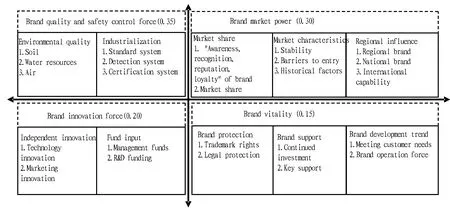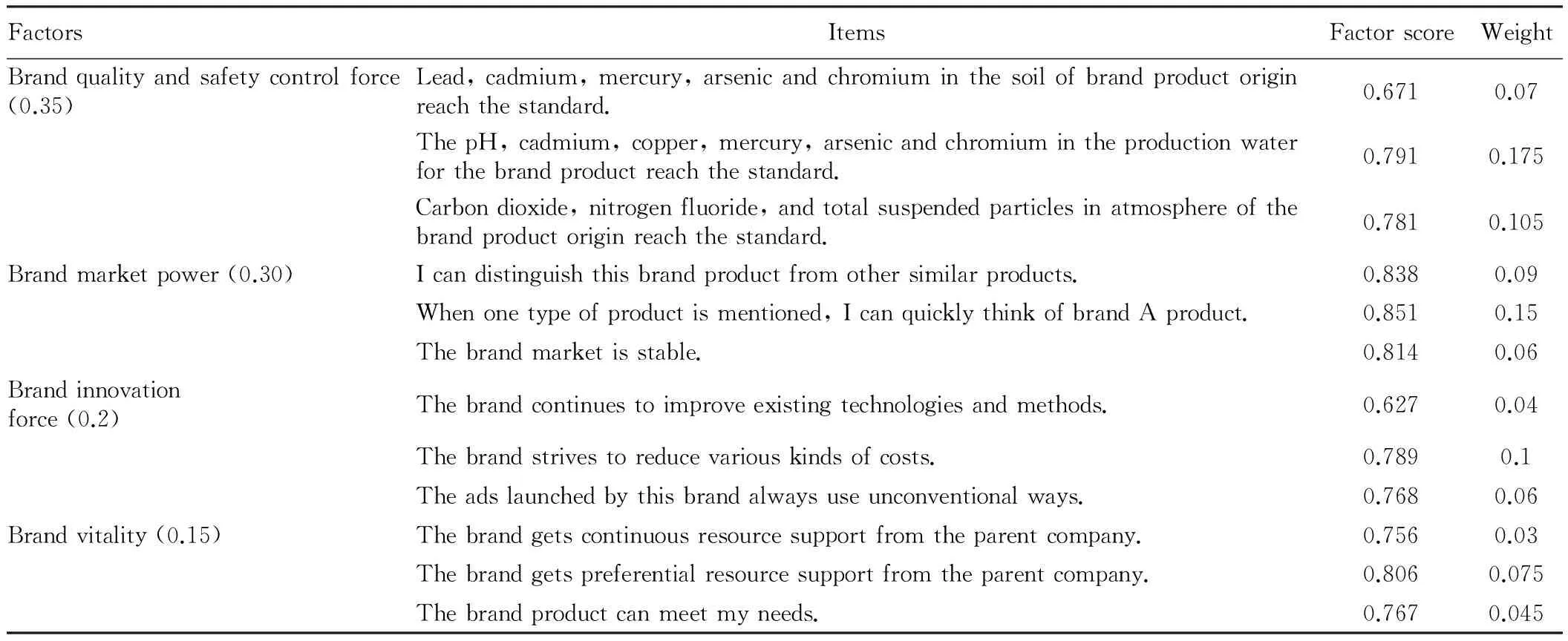Establishment of Chinese Agricultural Brand Value Scale and Study of Its Reliability and Validity Based on Customer Value
, ,
College of Economics and Management, Huazhong Agricultural University, Wuhan 430070, China
1 Introduction
Agricultural branding is an inevitable result of market-oriented, specialized and socialized agricultural production. The level of China’s agricultural branding is not high, and it is now in a critical period of industrial upgrading and brand creation. Agricultural brand is the extension and use of brand concept in agricultural products, and it can be used to identify agriculture-related product attributes, representing product managers’ pledges and commitments for consumers, so it is intangible asset for agricultural product owners. Agricultural brand is formed on the basis of product differentiation, and there are a variety of reasons for this differentiation, including the differences in types, production areas, production methods and marketing methods. Customer value, as the value orientation of customer, leads to the relationship with consumer spending behavior. Foreign scholars’ studies on customer value are focused on the following aspects. The first is the definition and connotation of customer value. Forbisetal. (1981) believe that customer economic value refers to the highest value that consumers are willing to pay when they know comprehensive information about known core products and other products, and can obtain the competing products (Forbis JL, Mehta NT, 1981). Christopher (1982) points out that customer value is the price that customers are willing to pay in order to get goods, and such willingness to pay is the perceivable benefit provided by goods to the customer (Christopher M, 1982). The second is how companies provide high-quality customer value for customers based on the correct understanding of customer value. In this regard, Philip Kotler, Porter and Carpenter all put forward their respective views. In addition, some scholars, such as Desarbo, try to quantify the customer value. Brand value mainly consists of cost value, relationship value and rights value. Brand value is the stable future excess return brought by brand to the enterprise, and it is an intangible asset of brand. It needs the enterprise’s efforts on brand operating and maintenance, and it also depends on the consumer’s internal cognition of brand, and is the result of interaction between enterprise and consumer. Agricultural brand value, on the basis of this definition, is the further expansion in the field of agriculture. In this study, based on brand value, we put forward the agricultural brand value evaluation methods in line with Chinese agricultural brand characteristics, establish the indicator evaluation system for Chinese agricultural brand value, analyze the current situation of brand value, and explore the reasons for low agricultural brand value in China.
2 Evaluation system for agricultural brand value
2.1EvaluationdesignofagriculturalbrandvalueIn this study, referring to the agricultural brand value evaluation system established by Li Min (2008) and MSQD method developed by Bai Guang and Ma Guozhong (2006), we divide the agricultural brand value evaluation system into brand market power, quality and safety control force, brand innovation force, and brand vitality of agricultural products. The intensity indicators of agricultural brand value are divided into 4 first level indicators, 10 second level indicators, and 24 third level indicators, and the weight of each evaluation indicator is calculated according to the Delphi method. The quality and safety control force of brand is selected due to the particularity of agricultural products. The quality and safety level of agricultural products is constrained by the environmental quality in the origin and industrialization level. Brand market power includes brand’s market share, market characteristics and regional influence. In terms of brand innovation force, capability of independent innovation has become a core factor of brand value competitiveness, and scientific fund management and R&D investment is an inexhaustible motive force to promote innovation of the brand. In terms of brand vitality, on the one hand, it focuses on the existing viability of brands and examines whether the brands comply with the law and are protected by law; on the other hand, it also focuses on the future development of brands, and examines the efforts of enterprises in brand operation. To ensure that the data obtained are really reliable and truly reflect the operation of enterprises, we can use industrial analysis report of agricultural products and company’s open annual report, as well as the financial, business management and service information obtained by the enterprises. For the qualitative part, the third-party evaluation institutions and internal and external experts in the project team are responsible for scoring, and necessary conversion is performed, to get scientific evaluation results of agricultural brands.

Fig.1 The evaluation indicator system model for Chinese agricultural brand value
2.2ComputingformulaofagriculturalbrandvalueBrand value, like other similar economic assets, is the present value of ownership benefits. The formula is as follows:
brandvalue=brandbenefit×brandstrengthmultiplier
wherebrandbenefitrepresents the expected excess profit brought by brand;brandstrengthmultiplieris determined primarily by the strength of the brand.
In the process of calculating brand benefit, the core is to determine the profits of the brand, which is the foundation of the entire assessment. In calculating brand value, it uses the profit after tax for three consecutive years, and under normal circumstances, it uses the average of the company’s effective tax rate. The specific formula is as follows:
brandearnings=(earnings×3+earningsinthepreviousyear×2+earningsintheyearbeforelast×1)/(3+2+1).
The calculation of brand strength coefficient is based on the brand value computing method of Interbrand, and the formula of relationship between brand strength and brand strength multiplier is as follows:
250y=x2,x∈[0, 50]; (y-10)2=2x-100,x∈(50, 100]
wherexis the brand strength score;yis the brand strength multiplier.
2.3AgriculturalbrandvaluescaleIn this paper, based on the four dimensions of evaluation indicator system model for Chinese agricultural brand value (Fig. 1), referring to the relevant literature, we design the items in line with agricultural brand value assessment (Table 1). (i) The first level indicator of brand quality and safety control force is divided into two second level indicators (environmental quality and industrialization). Environmental quality includes three items, and industrialization also includes three items. (ii) The first level indicator of brand market power is divided into three second level indicators (market share, market characteristics and regional influence). Market share has four items, market characteristics include three items, and regional influence has three items. (iii) The first level indicator of brand innovation force is divided into two second level indicators (independent innovation and fund input). Independent innovation has five items and fund input has two items. (iv) The first level indicator of brand vitality includes three second level indicators (brand protection, brand support and brand development trend). Brand protection has two items, brand support has two items, and brand development trend has two items.
3 Empirical survey and analysis
3.1SampledistributionIn this survey, a total of 1200 questionnaires are given out, and 1060 valid questionnaires are returned. The questionnaire involves distribution of samples in each dimension. The ratio of male to female respondents is about 1.2: 1, basically reaching a balance; more than 80% of respondents receive bachelor degree or above; most of respondents work in enterprises and institutions, or are self-employed, or work freelance from home, accounting for 97% of total samples; 88.8% of respondents’ annual household income is less than 80000 yuan, but there are still 19.2% of respondents with annual household income of 80000-150000 yuan; in terms of purchase frequency of Chinese agricultural products, 94.5% of respondents purchase products every day; in terms of purchase expense, 98.5% of respondents pay expense of more than 200 yuan, and 79% of respondents pay expense of more than 500 yuan. In summary, the samples are largely representative.
Table1Agriculturalbrandvaluescaledesign

FirstleveldimensionSecondleveldimensionItemsSourcesBrandqualityandsafetycontrolforce(0.35)Environmentalquality(0.5)Lead,cadmium,mercury,arsenicandchromiuminthesoilofbrandproductor-iginreachthestandard.LiWenfengetal.(2011)ThepH,cadmium,copper,mercury,arsenicandchromiumintheproductionwaterforthebrandproductreachthestandard.Carbondioxide,nitrogenfluoride,andtotalsuspendedparticlesinatmosphereofthebrandproductoriginreachthestandard.Industrialization(0.5)Thebrandproductmeetsnationalstandards,industrystandardsandregionalstandardsinproduction.Thebrandproductgetsorganicproductcertification,GAPcertification,HACCPcertification,andgreenmarketcertification.Intermsoftesting,thebrandproductmeetsnationalstandards,industrystand-ardsandregionalstandards.Brandmarketpower(0.30)Marketshare(0.5)Thebrandproductisverywell-knowninthesimilarproducts.Yooetal.(2000)Consumersarewillingtopayacertaindegreeofreasonablepremiumstobuythebrandproduct.QiuXiaodongetal.(2002)Icandistinguishthisbrandproductfromothersimilarproducts.Keller(1993)Whenonetypeofproductismentioned,IcanquicklythinkofbrandAproduct.WangXiaoyun(2011)Marketcharacteristics(0.3)Thebrandmarketisstable.Economiesofscale,highcosts,resourceoccupation,productdifferentiation,andpolicyandregulationbarriers,makeotherbrandsofsimilarproductsdifficulttoenter.LiMenggangetal.Thebrandhasalonghistory.Regionalinfluence(0.2)Productionandmarketingofonebrandproductiscompletelyfinishedinasmallregion,andallsalesarefromthisregion.WangFenmianetal.Productionandmarketingofonebrandproductisthroughoutthecountry,andsalesarefromacrossthecountry.Productionandmarketingofonebrandproductisthroughouttheworld,andmorethan20%ofsalesarefrominternationalmarkets.Brandinnovationforce(0.2)Independentinnovation(0.5)Thebrandcontinuestoimproveexistingproductsorservices.Sandsetal.(1977)Thebrandcontinuestoimproveexistingtechnologiesandmethods.Thebrandstrivestoreducevariouskindsofcosts.Theadslaunchedbythisbrandalwaysuseunconventionalways.YangZhi(2006)Thebrandseldomadoptthedistinctivemarketingtools.Fundinput(0.5)Thebrandcontinuestoinvestmanagementfundsininnovation.ThebrandcontinuestoinvestR&Dfundsininnovation.Brandvitality(0.15)Brandprotection(0.3)Whenthetrademarkrightsareviolated,thebrandconductsactiveprotection.HanBing(2005)Thebrandregisterstrademarktimelyandproperly,andisprotectedbyTrade-markLaw.WuYouping(2002)Brandsupport(0.4)Thebrandgetscontinuousresourcesupportfromtheparentcompany.Thebrandgetspreferentialresourcesupportfromtheparentcompany.Branddevelopmenttrend(0.3)Thebrandproductcanmeetmyneeds.Thebrandhastheabilitytoattractcustomersthroughthebrandpromotionandmarketexpansion.WangLike(2005)
3.2ReliabilityandvalidityanalysisIn reliability test, α coefficient of agricultural brand value scale is 0.671, within the scope of reliability, so the reliability of the questionnaire meets the requirements. Validity test is divided into content validity test and construct validity test. The reference to high-quality questionnaire and previous in-depth interviews, have ensured the content validity of the questionnaire. In terms of structure validity, this study aims to explore the internal structure of consumers’ food safety psychological contract, so the factor analysis is used to test the construct validity of the questionnaire analysis. Bartlett sphericity test and KMO test results show that KMO of Chinese agricultural brand value scale is 0.789, andPis 0.000, indicating that it is suitable for factor analysis. Bartlett sphericity test is used to test the independence of the variables. Factor analysis results show that the internal structure of Chinese agricultural brand value consists of four common factors (Table 2), and the cumulative variance explanation rate is above 60%, so the construct validity of the questionnaire is good.
Table2Dimensionweightandfactornaming

FactorsItemsFactorscoreWeightBrandqualityandsafetycontrolforce(0.35)Lead,cadmium,mercury,arsenicandchromiuminthesoilofbrandproductoriginreachthestandard.0.6710.07ThepH,cadmium,copper,mercury,arsenicandchromiumintheproductionwaterforthebrandproductreachthestandard.0.7910.175Carbondioxide,nitrogenfluoride,andtotalsuspendedparticlesinatmosphereofthebrandproductoriginreachthestandard.0.7810.105Brandmarketpower(0.30)Icandistinguishthisbrandproductfromothersimilarproducts.0.8380.09Whenonetypeofproductismentioned,IcanquicklythinkofbrandAproduct.0.8510.15Thebrandmarketisstable.0.8140.06Brandinnovationforce(0.2)Thebrandcontinuestoimproveexistingtechnologiesandmethods.0.6270.04Thebrandstrivestoreducevariouskindsofcosts.0.7890.1Theadslaunchedbythisbrandalwaysuseunconventionalways.0.7680.06Brandvitality(0.15)Thebrandgetscontinuousresourcesupportfromtheparentcompany.0.7560.03Thebrandgetspreferentialresourcesupportfromtheparentcompany.0.8060.075Thebrandproductcanmeetmyneeds.0.7670.045
4 Conclusions
This study explores the key components of Chinese agricultural brand value, and establishes the theoretical framework of Chinese agricultural brand value. The building of evaluation indicator system for agricultural brand value and research results of its influencing factors, can provide practical guidance for the construction of agribusiness brand, regional agricultural brand and Chinese agricultural brand. Meanwhile, it is of great significance to promoting transformation and upgrading of modern agriculture, deepening rural reform, implementing agricultural and rural economic development plan, solving issues concerning agriculture, farmers and countryside, improving the quality of agricultural products and food safety, increasing farmers’ income, enhancing the international competitiveness of agricultural brand, and achieving the shift from agricultural power to agro-brand power.
[1] LI M, YI FH. The premise and key of brand marketing of agricultural products [J]. Modern Agricultural Science and Technology, 2007(1): 119-120. (in Chinese).
[2] LI NH, LI L, SHEN W,etal. Strategic brand management [M]. Beijing: China Renmin University Press, 2003:80-85.(in Chinese).
[3] AL R, JACK T. Positioning [M]. Beijing: China Financial & Economics Publishing House, 2002: 53-67.(in Chinese).
[4] JACK T, STEVE R.New positioning [M]. Beijing: China Financial & Economics Publishing House, 2002:67-75.(in Chinese).
[5] AL R, JACK T. Bottom-up marketing [M].Beijing: China Financial & Economics Publishing House, 2002:1.4.(in Chinese).
[6] HUANG GL. The rise and decline of famous brand and urban competitiveness [J]. China Trademark, 2003(12): 14-16. (in Chinese).
[7] JIANG MH, CAO HX. A comparative study of brand image models [J]. Journal of Peking University(Humanities and Social Sciences),2003(2):107-114.(in Chinese).
[8] LIU DM. Agriculture industrialization and agricultural products circulation [M]. Beijing: China Modern Economics Publishing House,2001: 87-90.(in Chinese).
[9] SUN Y. Agricultural brand construction analysis and strategy countermeasures [D]. Ji’nan: Shandong University, 2010. (in Chinese).
[10] WANG J. Study on the act of government to brand integration of agricultural products [J]. Problems of Agricultural Economy,2014(5): 21-26. (in Chinese).
[11] YANG H. Promoting brand marketing of agriculture and boosting brand value of agricultural products [J]. Science and Technology of Sichuan Agriculture,2008(4): 7-9.(in Chinese).
[12] YANG QS. Exploration and analysis on brand strategies of agricultural products [J]. Rural Economy,2004(4): 52-54. (in Chinese).
[13] ZHANG KC, WANG XY. Analysis on brand construction of agricultural products in China [J]. Problems of Agricultural Economy, 2009(2):32-34.(in Chinese).
[14] AAKER DA. Managing brand equity: Capitalizing on the value of a brand name [M]. New York: Free Press,1991.
[15] BIEL ALEXANDER L. How brand drives equity[J]. Journal of Advertising Research, 1992,32(6):6- 12.
[16] CRASK M. RICHARD J. STOUT RG. Marketing research principles and applications[R]. Prentice-Hall Inc, 1995.
[17] AAKER DA. Managing brand equity [M].New York:Free Press,1991.
[18] AAKER J. Dimensions of brand personality[J].Journal of Marketing Research,1997(34):342-352.
[19] BANDURA A.Social foundations of thought and action:A social cognitive theory[M]. Englewood Cliffs,New Jersey:Prentice—Hall,Inc.1986.
[20] BELEN A. VAZQUEZ RI. Effects of brand association on consumer response[J].Journal of Consumer Marketing,2001,18(5):410-425.
[21] BIEL AL.How brand image drivers brand equity[J].Journal of Advertising Research,1993(6):6-12.
 Asian Agricultural Research2016年5期
Asian Agricultural Research2016年5期
- Asian Agricultural Research的其它文章
- Is It Worthwhile for Farmers to Grow Grain?—A Study of Farmers’ Behavior of Growing Grain
- How to Develop Chinese Rural Tourism in the Context of New Urbanization?
- Chinese Customers’ WTP for Legal Digital Music Downloading
- High Standard Capital Farmland Construction Based on Grain Security
- Research on the Brand Construction of Agritourism Enterprise in Chongqing
- An Empirical Study on How to Intensively Use Land and Tap Land Potential in Ma’anshan City
